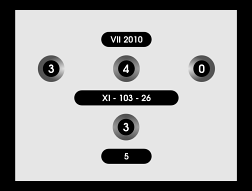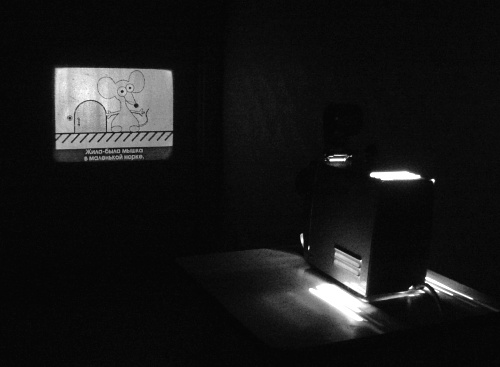Open Source ... filmstrip!
 So the time has come when you won't surprise anyone with a domestic video projector or a plasma panel with a diagonal of one and a half meters. Technologies are moving forward, and a full-fledged three-dimensional television is not far off. It is even more interesting to remember what devices were used for gray days 30-40 days ago. And not just to remember, but to try to cross their possibilities with the capabilities of modern digital technologies.
So the time has come when you won't surprise anyone with a domestic video projector or a plasma panel with a diagonal of one and a half meters. Technologies are moving forward, and a full-fledged three-dimensional television is not far off. It is even more interesting to remember what devices were used for gray days 30-40 days ago. And not just to remember, but to try to cross their possibilities with the capabilities of modern digital technologies.So, there is a rare device - a projector of filmstrips "Screen" of 1977 of release. The projector is fully operational if it were not for one thing: the filmstrips on the film after years of age have lost their color / contrast so much and faded away that it is very difficult to see something on the projected picture. What to do? DIY blog readers already know the answer - need to make a filmstrip yourself!
In general, I came up with, and what is most interesting, I checked, a truly "folk" method of making films. (I understand, I understand, few need it ... damn, but nobody needs it at all! But if I’m here, I’m going to continue ...) It is extremely simple, it requires only a domestic computer and a printer, selling in any city.
')
That is, we will not bother with applying a filmstrip on the film, developing and fixing with chemical reagents. We'll print the filmstrip! On a conventional laser printer. On the usual transparent film Lomond, which will be sold in computer stores. Current resolutions of black and white laser printers are 1200 dpi, which is quite enough to get 1050x800 pixels on a standard filmstrip frame. Yes, the filmstrip will turn out to be black and white, but is it really a disadvantage if the process of creation is pure creativity, close to cinema and animation? Yes, yes, we will not print ready-made scans of Soviet film strips - we will make our film strip absolutely “from scratch”.
Lyrical digression . When I was little, I really liked filmstrips. The viewing process always reminded me of some mystery. First, the film is tucked into the projector, necessarily "upside down." Turns off the light, aligns the position of the picture on the wall, adjusts the sharpness. The first frame appears and viewing begins. People sit quietly in the dark, only the slots on the projector and the screen glow. Each frame of the filmstrip leaves under the quiet creak of the roller spinning under the operator’s fingers. Someone reads the captions aloud, and when everything has been reviewed, scrolling to the next frame begins. While scrolling is going on, many are waiting - what will happen next? The process is slow, but very exciting.
So, we will begin to implement our idea. We need a computer, a vector drawing program, a 1200dpi laser printer, and a transparent film for laser printers.
First we draw a filmstrip in the vectors. To do this, you need to know the standard frame sizes (I measured them on a regular filmstrip):

On the A4 sheet vertically fits 14 frames. If the filmstrip is longer, several columns can be printed on the same sheet at once, then glued together with acetone. When drawing the main thing not to become too small, and remember that the final picture will be about 1050x800 pixels in size. After drawing, you need to print the filmstrip on a sheet of white paper, check the resulting dimensions, examine the quality of the image under a magnifying glass, in general, find the optimal printing mode. When everything suits, finally print on a sheet of transparent film.
Then, using a pair of scissors or a sharp cutter, the printed tape is cut, glued together, if necessary, and inserted into the projector. Everything! You can start browsing.
As a test of my idea, I painted a short 12 frame filmstrip, printed it, and inserted it into a slide projector. And I was pleasantly surprised - pixelization on an enlarged image by an overhead projector is almost invisible, while the black and white picture itself looks like frames from an old silent movie. I almost felt like Charlie Chaplin, who, as we know, was not only a great director, but also experimented a lot with filming technology.

The paint on the film is held tight, after several views of the degradation and shedding of the picture did not happen. The film does not melt from the lamp inside the overhead projector, as it is designed to make contact with the heated drum of a laser printer.
In general, the experiment turned out. But the most successful luck I think is that my child took the black-and-white filmstrip perfectly, and after watching it showed several times how the cat jumped for a mouse and how it ran away.
Little about the filmstrip
The filmstrip is called "Mouse and Cheese." The plot is built according to the canons of dualism, and imbued with reflections on the characters of the characters. On the one hand, the mouse goes wrong, craving someone else's cheese. On the other hand, she is a brave and quick-witted person who has managed to use evil for her own good. The image of evil in the form of a cat serving as an invisible owner will not leave indifferent any aesthetic critic.
... I was wondering whether to post a filmstrip preview here. Recalling that the people famously placed xkcd comics, he decided - what about a dozen shots of filmstrip worse? Reduce the speed of reading, and slowly rewind, looking at the perfection of the lines in each frame:

In conclusion, I give links. Let me forgive the habrasoobshchestvo, but I give links to the file sharing service, as I am afraid that my server may not withstand.
Filmstrip (vector) as an SVG file: http://rghost.ru/2674015
Filmstrip (vector) as XAR file: http://rghost.ru/2674037
Filmstrip (raster) as a single PNG image, 1200 dpi: http://rghost.ru/2674061
Filmstrip (raster) in the form of a set of PNG-pictures for viewing on the monitor: http://rghost.ru/2674095
A more detailed article on how a filmstrip was made and printed on my website: http://webhamster.ru/site/page/index/articles/hmake/6 . Request! For downloading files it is better to use the above links.
And what have the Open Source? Yes, despite the fact that the SVG-sources of filmstrip are open, and all files are published under the license CC BY-ND. Art must belong to the people!
Source: https://habr.com/ru/post/104717/
All Articles